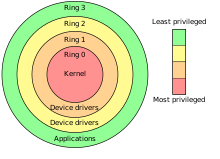| Revision as of 23:13, 17 March 2015 editRemember the dot (talk | contribs)Edit filter managers, Autopatrolled, IP block exemptions, Administrators31,469 edits replaced hideous image, removed stub tag← Previous edit | Revision as of 09:58, 29 November 2015 edit undoJulthep (talk | contribs)Extended confirmed users1,987 editsmNo edit summaryNext edit → | ||
| Line 3: | Line 3: | ||
| A '''privilege level''' in the ] ] controls the access of the program currently running on the processor to resources such as memory regions, I/O ports, and special instructions. There are 4 privilege levels ranging from 0 which is the most privileged, to 3 which is least privileged. Most modern operating systems use level 0 for the kernel/executive, and use level 3 for application programs. Any resource available to level n is also available to level 0..n, so the privilege levels are "]". When a lesser privileged process tries to access a higher privileged process , a General Protection Fault is reported by the OS. | A '''privilege level''' in the ] ] controls the access of the program currently running on the processor to resources such as memory regions, I/O ports, and special instructions. There are 4 privilege levels ranging from 0 which is the most privileged, to 3 which is least privileged. Most modern operating systems use level 0 for the kernel/executive, and use level 3 for application programs. Any resource available to level n is also available to level 0..n, so the privilege levels are "]". When a lesser privileged process tries to access a higher privileged process , a General Protection Fault is reported by the OS. | ||
| It is not necessary to use all four privilege levels. Existing software that was designed to use only one or two levels of privilege can simply ignore the other levels offered by the 80386 and later processors. A one-level system should use privilege level zero; a two-level system should use privilege levels zero and three. Here level zero is called the Supervisor mode while level three is User mode. All versions of Windows below ] use only the two-level system.<ref>Russinovich, Mark E.; David A. Solomon (2005). Microsoft Windows Internals (4 ed.). Microsoft Press. pp. 16. ISBN 978-0-7356-1917-3</ref> | It is not necessary to use all four privilege levels. Existing software that was designed to use only one or two levels of privilege can simply ignore the other levels offered by the ] and later processors. A one-level system should use privilege level zero; a two-level system should use privilege levels zero and three. Here level zero is called the Supervisor mode while level three is User mode. All versions of Windows below ] use only the two-level system.<ref>Russinovich, Mark E.; David A. Solomon (2005). Microsoft Windows Internals (4 ed.). Microsoft Press. pp. 16. ISBN 978-0-7356-1917-3</ref> | ||
| The real mode programs in 8086 are executed at level 0 (highest privilege level) whereas virtual mode in 8086 executes all programs at level 3.<ref>Sunil Mathur, "Microprocessor 8086: Architecture, Programming and Interfacing" , Eastern Economy Edition, PHI Learning</ref> | The real mode programs in 8086 are executed at level 0 (highest privilege level) whereas virtual mode in 8086 executes all programs at level 3.<ref>Sunil Mathur, "Microprocessor 8086: Architecture, Programming and Interfacing" , Eastern Economy Edition, PHI Learning</ref> | ||
Revision as of 09:58, 29 November 2015

A privilege level in the x86 instruction set controls the access of the program currently running on the processor to resources such as memory regions, I/O ports, and special instructions. There are 4 privilege levels ranging from 0 which is the most privileged, to 3 which is least privileged. Most modern operating systems use level 0 for the kernel/executive, and use level 3 for application programs. Any resource available to level n is also available to level 0..n, so the privilege levels are "rings". When a lesser privileged process tries to access a higher privileged process , a General Protection Fault is reported by the OS.
It is not necessary to use all four privilege levels. Existing software that was designed to use only one or two levels of privilege can simply ignore the other levels offered by the 80386 and later processors. A one-level system should use privilege level zero; a two-level system should use privilege levels zero and three. Here level zero is called the Supervisor mode while level three is User mode. All versions of Windows below Windows XP use only the two-level system. The real mode programs in 8086 are executed at level 0 (highest privilege level) whereas virtual mode in 8086 executes all programs at level 3.
See also
References
- Russinovich, Mark E.; David A. Solomon (2005). Microsoft Windows Internals (4 ed.). Microsoft Press. pp. 16. ISBN 978-0-7356-1917-3
- Sunil Mathur, "Microprocessor 8086: Architecture, Programming and Interfacing" , Eastern Economy Edition, PHI Learning
- Intel 80386 Programmer's Reference